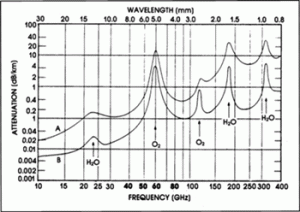 The success of personal wireless communications may have been inevitable: communications is an essential tenant of human social structure. Coupled with the proliferation of wireless communication has been a drive to open up new bands of frequency spectrum. The most recent example is the millimeter wave band around 60 GHz which was assigned for unlicensed use and is now part of 802.11ad standard activities. In other words, WiFi operation in 60 GHz is work in progress! But looking further ahead, what new bands can be made available?
The success of personal wireless communications may have been inevitable: communications is an essential tenant of human social structure. Coupled with the proliferation of wireless communication has been a drive to open up new bands of frequency spectrum. The most recent example is the millimeter wave band around 60 GHz which was assigned for unlicensed use and is now part of 802.11ad standard activities. In other words, WiFi operation in 60 GHz is work in progress! But looking further ahead, what new bands can be made available?
We can answer this question by looking at the properties of the 60 GHz band. It does have a unique feature of being highly susceptible to atmospheric absorption: the oxygen in the air attenuates the electromagnetic wave at a rate close to 20 dB per kilometer. By comparison, atmospheric absorption in sub 6 GHz bands over which mobile and local area network systems operate encounter less than 0.01 dB per kilometer of attenuation.
While high attenuation is undesirable in communication systems seeking to achieve range, communication over short distances can still be achieved at 60 GHz and at very high data rates. Assuming a transceiver with basic capability of 1 b/s/Hz spectral efficiency which is very low by today’s standards, we can manage a phenomenal 7 Gbps in throughput (the 60 GHz band spans 57 – 66 GHz but the largest allocation is 7 GHz within this range). Furthermore, high atmospheric absorption serves to contain interference which is of prime benefit to unlicensed spectrum applications. This property was a motivation for the FCC and Ofcom to take the lead to designate the 60 GHz band as unlicensed and open up its use in the mid-2000’s, a move that consequently stimulated research and development so that today there is a plethora of products and applications in this band.

Average atmospheric absorption of millimeter-waves at sea level (line A, Temperature=20oC, Pressure=1013.25 mb, Water Vapor Density= 7.5 g/m3) and altitude of 4 kilometers (line B, Temperature=0oC, Water Vapor Density= 1 g/m3) .
Following the atmospheric absorption curve, we note the peaks at 180, 330 and 380 GHz. These bands would have similar features to those of 60 GHz and are prime candidates for future use in unlicensed wireless communication systems. To make effective systems in such bands research on integrated circuit technology is fundamental, specifically in low-cost CMOS ICs. While we may still be several years away from such possibilities, I am certain that one day communication systems taking advantage of these bands will emerge bringing in exciting new possibilities in integrated system design including antennas that will leverage the minute wavelength for array processing.